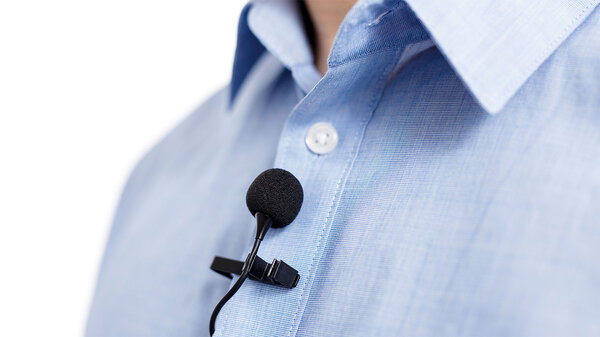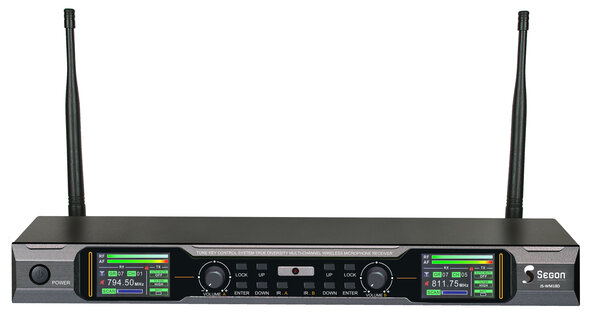In the professional audio landscape, wireless microphones are widely used in events, live performances, audiovisual productions, as well as conferences and corporate presentations. In this article, following an introductory overview, we will examine Italian radiofrequency regulations with the latest updates included in the PNRF 2025, along with compatibility issues. We will then look at handheld transmitters and systems with headworn / lavalier microphones and bodypack transmitters, referencing solutions offered by Audio Effetti.
Wireless microphones, consisting of a transmitter and a receiver, rely on VHF/UHF analog or digital transmission technologies to ensure a stable and reliable vocal signal. Analog UHF transmission uses FM modulation, similar to traditional (non-DAB) broadcasting, but with technical and functional differences due to narrower bandwidth, higher operating frequencies, and most importantly the point-to-point nature of the transmission, as opposed to broadcast systems.
On the transmitter side, there is always a microphone capsule, either dynamic or condenser, integrated directly into the handheld transmitter (which also contains the RF section and antenna), or connected externally in the case of headworn or lavalier microphones.
The receiver may be rack-mountable (half-rack or 19") or beltpack-type, although the latter is less common, since the receiver must be wired to the audio system downstream. This differs from Intercom or IFB systems, which are bidirectional.
The choice of wireless microphone depends on the application, required mobility, and desired audio quality. There are wireless microphone systems designed for non-critical environments, such as presentations or sporting activities, and others where high audio fidelity is essential, such as live concerts or on-set recording for film and advertising. Cost varies accordingly.
One thing, however, remains constant: maximum operating range and resistance to audio dropouts are always desirable features, regardless of the application.
Radio frequencies and regulatory framework
This has always been one of the most sensitive topics concerning wireless microphone systems and wireless transmission in general.
As of July 1, 2022, the UHF frequency band from 698 to 790 MHz may no longer be used for wireless microphones, having been permanently reassigned to 4G/5G mobile services, as mandated in the updated National Frequency Allocation Plan (PNRF).
The PNRF has undergone multiple revisions over time to accommodate spectrum reassignments caused by emerging technologies most recently 5G. This year, the plan incorporated the directives of the WRC-23 (World Radiocommunication Conference) and officially recognized new license-exempt bands for wireless microphones.
While this reallocation helped regulate what was previously a rather chaotic situation, it has caused significant difficulties for operators who had to switch to different frequencies often encountering interference issues due to crowded or “contaminated” electromagnetic environments, sometimes solvable only through methods outside regulatory compliance.
We emphasize “when possible” because wireless microphone systems are sold in frequency blocks, chosen at the time of purchase. With the reshuffling of available bands, previously purchased equipment may no longer support the newly allowed frequencies resulting in costly updates or, in the worst cases, complete system replacement.
The 698–790 MHz band, now off limits, was widely used before being reassigned to 4G, especially after operators were forced below 800 MHz in 2013 with the introduction of DVB-T digital television.
The 470–694 MHz band remains usable but only on a secondary basis, meaning wireless microphones must yield to primary services (digital terrestrial TV). Using inter-channel gaps in this range is possible but comes with operational limitations, including the obligation to shut down in case of interference.
Finally, the 734–736 MHz micro-range remains unsuitable due to proximity to interfering services and insufficient bandwidth (2 MHz) for professional use.
UHF wireless systems with handheld transmitters
Handheld wireless microphones are ideal for presentations, interviews, and vocal performances. They offer practicality and direct control and include a display showing the selected channel or frequency and battery status.
The antenna is typically integrated within the microphone body. Current transmission power limits range between 10 and 50 mW ERP, depending on the band. ERP expresses the actual radiated power, accounting for antenna gain and line losses.
A common value is 25 mW, although 10 mW is often preferred in handheld transmitters to avoid excessive heating, which can become uncomfortable during extended use.
Handheld transmitters (and wireless systems in general) employ companders (compressor + expander) to maximize audio quality at low transmission power. The limitation, however, is that companders in analog wireless systems are proprietary, meaning transmitters and receivers from different brands are generally incompatible.
Examples of UHF handheld systems from the Audio Effetti catalog:
- Single (1 TX + 1 RX): Rondson BE-5018/H-83, Audiophony PACK-UHF410
- Dual (2 TX + 1 dual-channel RX): Rondson BE-1020/2MIC-3, BoomTone UHF Duo (entry-level)
- Quad (4 TX + 1 four-channel RX): Rondson BE-1040/4MIC-1, or the more compact Rondson BE-2040/4MIC
All models are supplied with the appropriate receiver, and the frequency range is selected at the time of ordering.
UHF wireless systems with bodypack transmitters and headworn / lavalier microphones
When the presenter needs complete freedom of movement, handheld microphones may be unsuitable. In such cases, headworn (headband) or lavalier (lapel) microphones are preferred.
In this configuration, the microphone capsule is physically separated from the transmitter (bodypack), which is typically clipped to a belt or attached to clothing using a dedicated clip. Each type of microphone is suited to a specific application.
Headworn microphones are ideal for performers, instructors, and presenters, providing stability and comfort once fitted. For certain use cases such as live stage performances where the talent needs to move or dance, or fitness instruction a moisture- and sweat-resistant capsule is essential. In many situations, particularly in theatre productions, these microphones must be fully concealed under costumes or wigs. In such cases, the miniature size of both the boom arm (mini-boom) and the capsule itself becomes a key factor. When the headworn microphone also includes earphones or earpieces, it is more accurately referred to as a headset.
Lavalier microphones (also known as lapel or tie-clip microphones), on the other hand, are better suited for video production, broadcast applications, conferences, and similar contexts, where discretion and freedom of movement are essential. They are typically clipped to the collar, tie, or shirt edge.
Examples of UHF wireless systems with headworn microphones and bodypack transmitters from the Audio Effetti catalog include:
- Single-channel systems (1 MIC + 1 bodypack + 1 single-channel receiver): Audiophony PACK-UHF410-Head-F5
- Four-channel systems (4 MIC + 4 bodypacks + 1 four-channel receiver): Rondson BE-1040/4BP
Examples of UHF wireless systems with lavalier microphones and bodypack transmitters include:
- Single-channel systems (1 MIC + 1 bodypack + 1 single-channel receiver): Audiophony PACK GO-LAVA-F5
- Dual-channel systems (2 MIC + 2 bodypacks + 1 dual-channel receiver): Rondson BE-5038/2PT-10
These are, of course, only some of the available options, and mixed kits including both headworn and lavalier microphones are often offered as well.
The receiver: the heart of the wireless system
The receiver is responsible for decoding the RF audio signal and ensuring transmission stability, signal quality, and multi-transmitter compatibility in complex environments.
Higher-end models employ True Diversity reception, which uses two antennas and two independent receiving circuits; the system continuously selects the stronger signal, drastically reducing dropouts and interference particularly useful in crowded or obstructed environments.
Many receivers offer IR synchronization, transmitting the selected frequency to the transmitter automatically and simplifying setup.
Professional receivers also manage multiple frequency banks and preset channels, allowing interference-free multi-channel operation.
Receivers may be:
- Single-, dual-, or quad-channel
- Rack-mountable (19" or half-rack) for fixed installations
- Desktop format for portable setups
Outputs typically include balanced XLR, jack, mini-jack, and in some cases digital audio outputs.
In wireless systems for cameras, the receiver is compact and designed to mount onto mirrorless camera hot-shoe adapters. Advanced camera-link receivers may include IFB (Interrupted Feedback) capability, providing a return communication channel from the audio engineer or director to the talent wearing the bodypack.
Wireless microphone systems, in all their variants, represent a versatile and professional solution for wireless vocal transmission. The choice of system depends on the operating environment, required audio quality, and regulatory compliance. Thanks to recent advancements including 2.4 GHz digital transmission, intelligent frequency management, and infrared synchronization today’s systems deliver stability, reliability, and excellent performance even in challenging RF environments.
Audio Effetti offers a curated selection of wireless microphone systems designed to meet these needs, which can be found listed here.
Wanto to learn more?
Email us at international@audioeffetti.it

 English
English  French
French










